Become a Patron!
Status of Descendants of Africans Enslaved in the United States (DAEUS)
and the United States’s Violation of the Convention on the Elimination of All Forms Racial Discrimination (CERD)
Response to the Periodic Report of the United States of June 12, 2013,
accompanied by the Common Core Document
and Annex submitted on December 30, 2011,
to the United Nations Committee on the Elimination of Racial Discrimination
Submitted By
Racial Justice Now!
1. Key Findings
1. Widespread anti-black racism and the development of a new systemic structure of insitutional oppression has caused the economic, social and political well-being of black americans to approximate the system of legal apartheid in the United States from 1870 to 1964.
2. The United States fails to collect data on DAEUS and consequently fail to know the true status of descendants of Africans enslaved in the United States.
2. Recommendations
1. Amend census and data collection category to have more ethnic categories for Blacks including a category for DAEUS (Descendants of Africans Enslaved in the United States).
2. Conduct a racial impact study for all policies and laws with particular attention to the impact on DAEUS, develop and delivered to Govt Agencies and contractors concerning anti-black racism, systemic acism analysis and ICERD obligations.
3. Revise anti-discrimination law to include negligent discrimination based on anti-black bias.
3. Who are DAEUS
4. Black American are people of black African descendant, including African Americans.
5. African Americans are black people who are descendants of enslaved Africans in the United States. Unfortunately, in popular culture, African American is often used to describe any American who is of Black African descent. For example, President Obama is described and self-identifies as African American even though his ancestors were not enslaved in the United States. For that reason, we will use the term "descendants of Africans Enslaved in the United States" (DAEUS) instead of African Americans.
6. Why Focus on DAEUS?
7. In order to understand the effects of systemic white supremacy and anti-black racism in the US, we need to understand the historical circumstances that make DAEUS a particularly vulnerable group.
8. The existence of DAEUS in the United States resulted from a unique confluence of historical events that brought Europeans, Native Americans, and Africans together, creating the so-called “New World” of the Americas based on Atlantic worlds of economic, cultural, and political connections. The racial and ethnic uniqueness of African Americans from the “discovery” and colonization of this “New World” and by subsequent events that culminated in the creation of the United States. The United States was established with a distinctive legal framework that espoused freedom and democracy while brutally suppressing people of African descent who were regarded as property and chattel. In three phases of American history, the law has been used to oppress people of African descent: the invention of racial slavery, the re-creation of slave-like condition through legal Apartheid (also known as Jim Crow) and the re-creation of Jim Crow through the new American Apartheid. 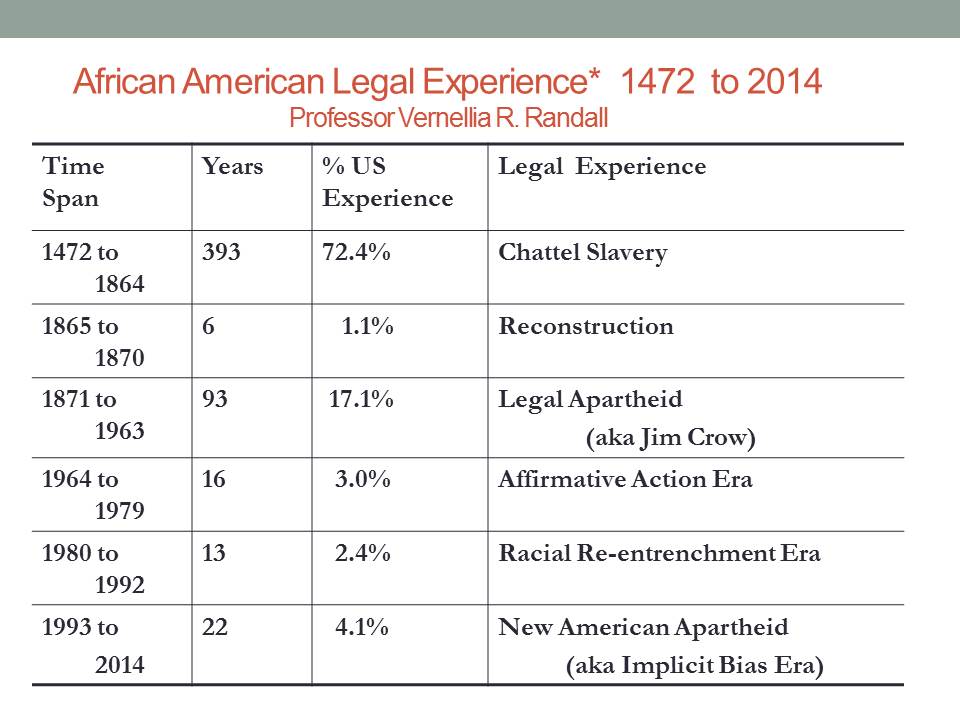 9. Understanding this historical trajectory is essential to understanding the situation of DAEUS. The cultural and social dynamics that followed each phase of these historical, targeted African Americans. Yet, African Americans fought, struggled, and died in an effort to hold the nation that was founded on the principles of freedom and democracy to these philosophical ideals. From 1492 through the Modern Civil Rights movement to today in the new American Apartheid, a system of white supremacy based on anti-black racism has been allowed to continue.
9. Understanding this historical trajectory is essential to understanding the situation of DAEUS. The cultural and social dynamics that followed each phase of these historical, targeted African Americans. Yet, African Americans fought, struggled, and died in an effort to hold the nation that was founded on the principles of freedom and democracy to these philosophical ideals. From 1492 through the Modern Civil Rights movement to today in the new American Apartheid, a system of white supremacy based on anti-black racism has been allowed to continue.
10. The situation of DAEUS is a result of racial slavery. Without the mass transfer of people from the African continent to the Americas, the invention of the white race, the construction of racial slavery under British colonial rule, and the consequent racial mixing with people of European and Native American descent, the racial category of African Americans would not exist. Because of the brutality of American slavery, most African cannot trace their family histories beyond their sale to a slaveholder. African Americans who can trace their ancestors to the period of slavery usually cannot pickup the trail into any specific country or tribe in African. They have no knowledge of their African ancestry, only that their forebears arrived in the "New World" as property. This is not only tragic, but it uniquely defines native-born African Americans as a special group in world history – we are a product of the creation of this “New World” and deserve special recognition as a people.
11. The horror of this Middle Passage was the start of the African American identity. The survivors of the Middle Passage came to comprise a generalized African culture through this shared experience of brutal suppression and exploitation.
12. In the “New World,” enslaved Africans were burdened with the responsibility of trying to understand themselves and form a new identity as their captors tried to strip them of their psychological and cultural individuality, identity and dignity. In the British North Americas the Africans were sent into regionally distinct colonies, each having established legal perpetual and hereditary slavery based on race. In each of these 13 colonies, people of African descent were held as property, and free blacks were less than and separate from whites under the law. Whether slave or free, to be black meant to either be enslaved or in a state close to slavery. For example, within the first century of Virginia’s establishment (the flagship colony of the British), laws defining hereditary enslavement were based on the woman’s slave status, enabling slaveholders to prosper from black women’s reproductive abilities, thus permitting the rape and forced breeding of enslaved women for the purposes of natural increase and for the profit of the slaveholder. There were miscegenation laws, where free blacks and free whites could not legally marry. The children of such unions were deemed “bastards” and were bound out by the courts. Frequently, enslaved children were separated from their parents and socialized as subjected people, as servants. The model of enslavement and the institution of racial slavery based on black subjugation in this first British colony in the New World set up the legal and economic model of slavery in Britain's other colonies.
13. There have been many deep and profound questions about how black slavery and white freedom could and would co-exist in a nation that was founded not only upon religious freedom, but also upon the principles of economic and political freedom and opportunity. The founding documents like the Declaration of Independence and the United States Constitution were written by slaveholders, and this allowed for an acceptance of the co-existence of slavery and freedom in the American mind, and the centrality of racial slavery and black subjugation in the nation’s legal and racial consciousness. Americans have therefore inherited an acceptance of legal racial disparities. Even the U.S. Constitution did not have any explicit references to slavery or enslavement; it was left up to federal and state lawmakers to decide whether or not a state would be slaveowning. This conflict of state laws led to the American Civil War.
14. Even though the Civil War was fought to eliminate slavery and Constitutional amendments secured citizenship rights for African Americans, a protracted system of black codes established legal apartheid at the federal and state levels. This legal apartheid, commonly known as Jim Crow, resulted in separate and unequal educational facilities and opportunities, inferior housing, limited access to quality health care, and limited economic and political opportunities. In addition, lynchings and murders of African American men and women went unprosecuted and created a climate of terror under which African Americans had no legal recourse.
15. This history, of American racial slavery and legal apartheid survives in the nation’s racial and legal consciousness and perpetuates racial disparities in the United States. However, many African Americans without doing their own family’s research, only know these broad strokes (if that) in their individual identity as a people or in their own understanding of self. It is a rich history, but one that is unveiled only through study and self-education. What makes African Americans unique is that they were placed into their national condition by force. Their segregation and subjugation as a result of their historical, political, and cultural, exploitation benefited the United States. The enslavement of African Americans thus gave other oppressed groups a legal, cultural, economic, and political advantage when they voluntarily migrated to the United States.
16. Anti-Black Racism and Its Impact
17. "There is no hierarchy of oppressions where race is concerned, but anti-black racism is the fulcrum of white supremacy." Scott Nakagawa
18. A fulcrum is "the spot about which a lever turns" or "one that supplies capability for action." Enslaved Africans and their descendants laid the economic foundation for American prosperity. At the same time, African Americans became the common enemy to unite "white -skinned" people. Fear and loathing of black people is the driving force of modern-day racial politics. Anti-black biases are so widespread that 70% of non-blacks and 40% of blacks reportedly have a pro-white, anti-black bias.
19. Anti-black racism is killing the descendants of Africans enslaved in the United States. By looking at the health of DAEUSs, one can get a full understanding of the impact of systemic racism.
20. In the United States, an estimated 80,000 to 200,000 excess black deaths occur each year. "Excess deaths" are those that would not occur if black Americans had the same death rate as white Americans. These figures are the equivalent of one jumbo jet of African-American passengers and crew crashing and killing everyone each day.
21. The figure on life expectancy can also show the impact of systemic racism on African-Americans. According to the World Factbook of the Central Intelligence Agency, life expectancy at birth is a measure of quality of life in a country.
22. Based on international comparisons of life expectancy, the quality of life for black American males and females is worse than in several countries, including Chile, Barbados, Cuba and Jamaica. That is if black American men life expectancy were ranked as a country at 69 years, black males ranked 75th behind Jamaica; black women ranked 55th behind Bosnia and similar to Jamaica. This ranking is 45 points lower than white males and 20 points lower than white females. The burden that is being carried by descendants of enslaved Africans in the United States (DAEUS) is unknown because the United States does not collect data specific to our status.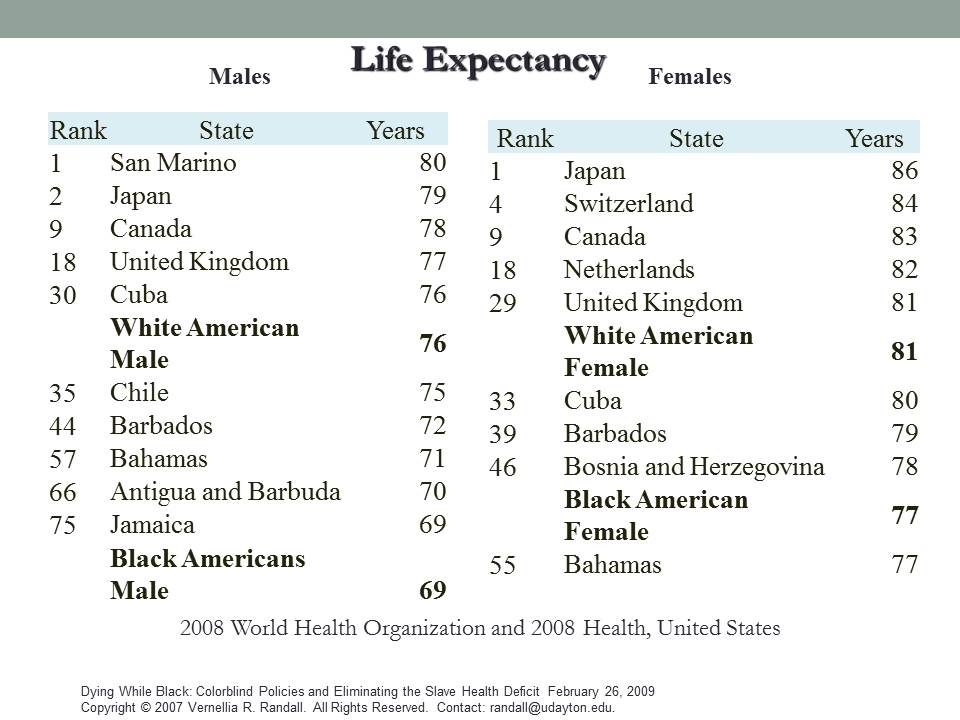
23. This difference in health is a result of institutional and systemic racism and the impact of slavery, legal apartheid, and the new American apartheid.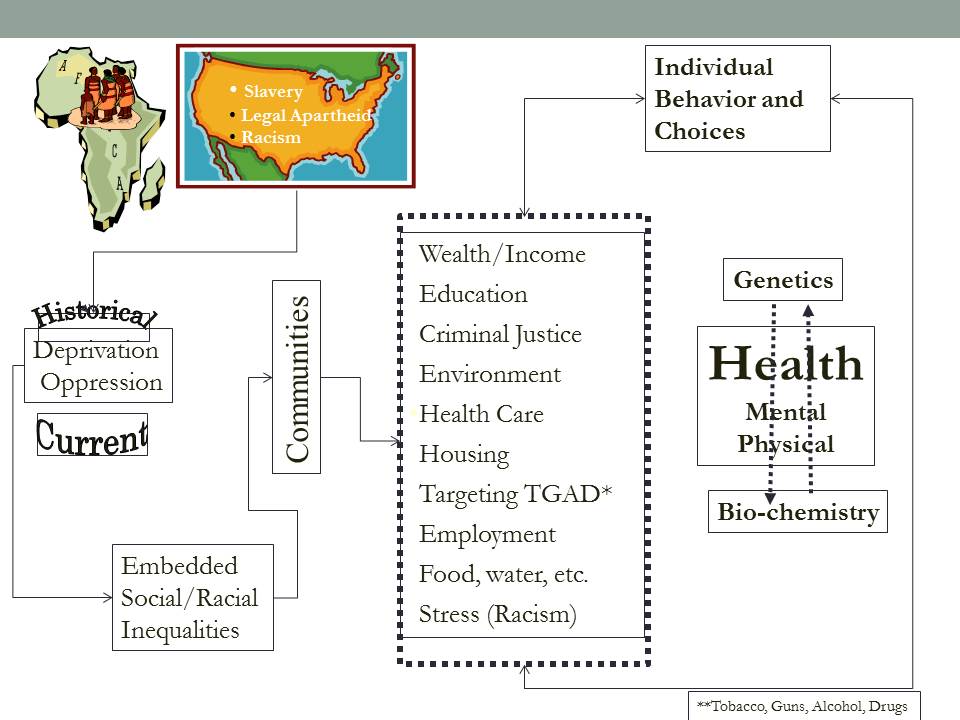
24. Distinguishing racism from classism is critical to understanding the state of DAEUS. According to one study, race and class are independent factors. Low-income whites live three years longer than low-income blacks, and middle-income whites lived ten years longer than middle-income blacks. In another study, black women with a college education had more low birth weight babies than white women with less than a high school education. This means that while middle-income blacks are doing better than low-income blacks, institutional and systemic racism prevents middle-income and poor blacks from doing as well as middle-income and poor whites.
25. This is because the United States has a system of oppression that is every bit as onerous as legal apartheid. Racially neutral laws and policies form the basis of the new American apartheid. However, these laws and practices are implemented in a way that has an unintended discriminatory effect. US anti-discrimination law addresses only intentional racism. Congressional Republicans and Democrats have both refused to allow African Americans and other’s access to the courts for implicit and institutional discrimination.
26. The old system of racism on which much of America law is based requires an explicit belief in white superiority, active promotion of segregation, a belief in a biological-based intellectual inferiority and blatant discrimination. This sort of discrimination is perpetrated by individuals and institutions. In the new American apartheid, the racial discourse and practices that have a discriminatory impact are increasingly covert based on implicit biases. The new American apartheid avoids racial terminology, claims that whites are also victims of discrimination, avoids direct racial references in politics, and has rendered the mechanisms of racial inequality invisible. The new American apartheid has reestablished many of the elements of legal apartheid. Among those elements are stated-sanctioned violence, residential and educational segregation, a system of economics that depends on keeping blacks from fully participating in the system, and restrictions on their political and civil rights.
27. This new American apartheid is promoted by both liberals and conservatives. Conservative defenders of the new American apartheid believe that the racial hierarchy is legally irrelevant to the constitutional principle of legal protection unless it is state-sponsored, conscious discrimination and unless that behavior is the proximate cause. The conservative response to racial inequality is to do nothing. Moreover, conservatives are convinced that racial re-marginalized groups should merely choose the proper cultural values so that they can take advantage of the new race-blind landscape.
28. Liberal supporters of the new American apartheid think that race does matter but not much. They are sometimes capable of being race-sensitive, but rarely. They view frontal attacks on racial conditions as divisive and prefer not to take direct action against racial inequality. They, like conservatives supporters of the new American apartheid are convinced that racially marginalized groups should just change their cultural values.
29. What both liberal and conservative supporters of the new American apartheid ignore is that systemic and cultural racism is having a devastating impact on the descendants of Africans enslaved in the United States.
30. The entire history of African slaves and their descendants has been one of deprivation and oppression. Our ancestors were stolen from the continent of Africa and dragged to the Americas. Slavery in the United States denied African slaves and their descendants any legal status, and severed their connections to their traditional culture, language, religion and history. African Americans or DAEUS origins are only here in the United States and cannot be compared to African immigrants or to any other racial or ethnic group.
31. Class, gender, religion and sexual orientation can complicate the situation of DAEUS. African Americans continue to suffer embedded social and racial inequalities that deprive them of opportunities and undermine the welfare of each member of the community regardless of his or her class .
32. Supporters of the new American apartheid fail to recognize that the choices that DAEUS make are based on the choices that are available to them. In the sea of racial oppression and deprivation, DAEUS do not have the same choices or receive the same treatment of that similarly situated whites do.
33. Violations of CERD
34. The United States has violated Articles 1(a), 1(c) and 1(d)m Article 2, 3 and Article 5 of the Convention on the Elimination of All Forms of Racial Discrimination.
35. The United States has violated Articles 1(a), 1(c), 1(d) by maintaining laws that permit and authorize discrimination based on negligent conduct rather than intentional conduct. The United States has blocked direct access to the court for disparate impact discrimination. In 2001, in Alexander v. Sandoval, the Supreme Court held that individuals could not sue for disparate impact discrimination because it was a right of action created through regulation. The Court held that the only recourse was to file a complaint with the appropriate government regulation. This could have been remedied by the passage of a law granting direct access to the courts. However, in the 13 years since that decision there has been no attempt to solve this problem. This is devastating since most discrimination is disparate impact or negligent discrimination based on implicit bias rather than intent. Thus, the United States has allowed a law to stand that perpetuates racial discrimination.
36. Article 3, Since slavery, the United States has maintained or supported legal segregation in housing and education. Despite the Brown v. Board of Education and Civil Rights Act of 1964, the segregation and isolation of black children has increased since 1990. In fact, “40 percent of black students attend schools that are more than 90 percent minority, up from 34 percent 20 years ago. Then, black students typically attended schools where 40 percent were low-income; it's now 60 percent.”
37. Furthermore, through mass incarceration, United States have de facto re-established slavery. The prison system has become a financial center fueled by black bodies. “Between 1990 and 2009, the inmate population of private prisons grew by 1,664% . Today approximately 130,000 people are incarcerated by for-profit companies. In 2010, annual revenues for two largest companies — Corrections Corporation of America and the GEO Group — were nearly $3 billion.”
38. Article 5(a), 5(b), 5©: African American (DAEUS) communities are immersed in a sea of systemic and cultural racism that limits the individual and community choices and opportunities. Systemic and cultural racism are evident in wealth and income discrimination, educational discrimination, criminal justice discrimination, healthcare discrimination, housing discrimination, employment discrimination, food and water discrimination, land discrimination, and in the targeting of DAEUS communities with tobacco, guns, alcohol and drugs.
39. The total 2013 Equality Index of Black America was 71.2%, meaning that black Americans enjoy less than 75% of the benefits and privileges that white Americans do.
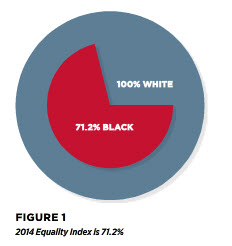
40. The situation has gotten worse since 2006, with the equality index dropping by two points. The most disturbing drop is in “Social Justice."
41. In eight years, Blacks have lost almost 20 points in “Social Justice," meaning that Blacks have only slightly more than 50% of the rights and opportunities that whites do when it comes to “equality before the law” and “victimization and mental anguish." This is due to rampant racial profiling and "Stand your Ground" laws which permit killings based on fear and suspicion. Given the anti-black bias, these laws are not enforced equitably.
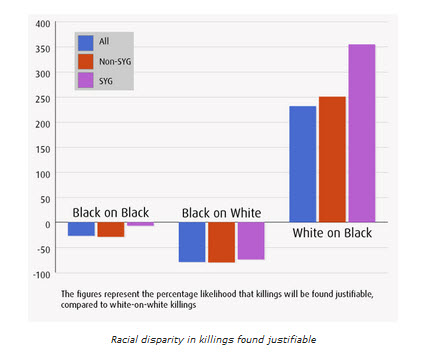
42. Even more disturbing is the widespread lynching of Black Americans. Between 1882 and 1968, there was 3446 known lynching. That is, on average 40 per year. In 2012, there were 136 extrajudicial killings or lynching of unarmed black men by police, security guards and vigilantes. On total, one black person was killed in an extrajudicial shooting every 28 hours.
43. Another area of racial oppression is the death penalty and mass incarceration. One black man in three and one black woman on ___ will be imprisoned at some point. This is especially disturbing as the for-profit prison system takes over responsibility for incarceration. Given the profit and economics in prisoners, it returns black bodies to the state of slavery and legal apartheid. The federal government has done little to stop this type of racial discrimination.
44. Systemic and cultural racism has an impact on all people of color: Asian, native American and Hispanic. Because of Anti-black racism, however, Blacks suffer disproportionately. The burden that is being carried by descendants of enslaved Africans in the United States (DAEUS) is unknown because the United States does not collect data specific to our status.
APPENDIX A: Black Farmers: It's Still About the land!
45. Black farmers in the United States continue to suffer from unlawful racial discrimination and persecution. Despite anti-discrimination laws, the United States Department of Agriculture (USDA) is responsible. Discrimination in the USDA farm loan and benefit programs has been well documented. This discrimination includes denial of production loans, other financial assistance available to white farmers, and program benefits. Black farmers continue to experience hostility, bias, and outright discrimination especially at the county-level offices of USDA.[1] In the 1980s, the USDA gutted its civil rights enforcement program and USDA Secretary Thomas Vilsack, appointed by President Obama, has failed to fire a single employee for discrimination that he maintains “happened twenty years ago.”
46. In 1932, when the USDA was founded, Blacks owned approximately sixteen million acres; today, that has dwindled to approximately three million, and Black farmers are struggling to hold on to that land for themselves and their children. Half of those three million acres are at risk of foreclosure. As Black farmers have been denied access to loans for chemicals and irrigation systems, they possess today the most virgin U.S. farmland available for organic, biodynamic farming
47. When Black farmers filed a class-action lawsuit against the USDA in Pigford v.Glickman, the Clinton Administration negotiated a settlement in 1999. There has been absolutely no progress since then. The problem has been allowed to fester and USDA has regressed on the issue of civil rights. Black farmers claim that they are being persecuted for bringing these issues to light and live in fear that USDA will take their farms. They contend that the USDA promised debt relief, but never delivered it. The United States government offsets any payment received by the Black farmers for discrimination by reducing the amounts of their pension, Social Security income, or other federal government payments. Further, because of these deliberate actions on the part of the United States government, Black farmers have poor credit histories that render them no choice but to pay as much as 49% interest when borrowing money to carry out their farming activity
48. The United States government does not hesitate to spend trillions of dollars on war. It is a shame when the US declares war on a segment of its own population.
[1] See for example, Decline of Black Farming in America, United States Commission on Civil Rights, Washington, D.C., February 1982 and The Minority Farmer: A Disappearing American Resource. Has the Farmers Home Administration Been the Primary Catalyst? H.R. Res. No. 101-984 (1990).
Appendix B Segregated Housing, Segregated Schools and Anti-Black Racism
49. Excerpted from: Richard Rothstein, Segregated Housing, Segregated Schools Education Week (March 24, 2014) http://www.edweek.org/ew/articles/2014/03/26/26rothstein_ep.h33.html (Last Visited: June 24, 2014).
50. . . . Even sophisticated policymakers now generally assert that black students' residential isolation is de facto, but the proposition is dubious.
51. The federal government led in establishing metropolitan residential segregation. From its New Deal inception, federally funded public housing was explicitly segregated by government. Nationwide (not only in the South), projects were officially designated either for whites or blacks. Once white families left the projects for the suburbs, most public housing was purposely placed only in black neighborhoods.
52. In the mid-20th century, the federal government subsidized relocation of whites to suburbs and prohibited similar relocation of blacks. The Federal Housing Administration and the Veterans Administration recruited builders to construct giant developments in the East . . . These builders received federal loan guarantees on explicit condition that no sales or resales be made to blacks
53. Federal and state bank regulators approved and encouraged "redlining" policies, banning loans to black families in white suburbs and even, in most cases, to black families in black neighborhoods, leading to those neighborhoods' deterioration and ghettoization.\\
54. The Internal Revenue Service unconstitutionally extended tax favoritism to universities, churches, and other nonprofits that enforced racial segregation. . . .
55. Urban renewal programs of the mid-20th century often had undisguised purposes of forcing low-income black residents away from universities, hospital complexes, or business districts and into new ghettos. Real estate is highly regulated, but state authorities never punished brokers for racial discrimination, and rarely do so even today when discriminatory practices remain. Public police and prosecutorial power enforced racial boundaries: North, South, East, and West, in thousands of incidents police stood by as mobs firebombed and stoned homes purchased by blacks in white neighborhoods, while prosecutors refused to charge easily identifiable arsonists. These and other forms of racially explicit state action to segregate the urban landscape violated the Fifth, 13th, and 14th Amendments. Yet the term "de facto segregation," describing a never-existent reality, persists among otherwise well-informed advocates and scholars.
56. Private prejudice certainly played a large role, but the federal government helped create and sustain private prejudice. White homeowners' resistance to black neighbors was fed by fears that African-Americans who moved into their neighborhoods would bring slum conditions with them. Yet slum conditions were created by overcrowding caused almost entirely by government refusal to permit African-Americans to expand their housing supply and by municipalities' discriminatory denial of public services. In the ghetto, garbage was collected less frequently, and neighborhoods were often rezoned for industrial or even toxic use. White homeowners came to see these conditions as characteristics of black residents themselves, not the result of racially motivated government policy.
57. Even those today who understand this dramatic history may think that because these policies are mostly those of the past, segregation persists mostly because few blacks can afford to live in middle-class neighborhoods.
58. Yet the federal government also contributed to this unaffordability with discriminatory labor-market policy. At the behest of Southern congressmen, New Deal labor standards, like minimum wages and the right to unionize, excluded from coverage, for undisguised racial purposes, occupations in which black workers predominated.
59. The federal government granted exclusive collective bargaining rights to segregated private-sector unions, including some that entirely excluded African-Americans from their trades, into the 1970s. Government thus depressed income levels of African-American workers below levels of comparable white workers, contributing to black families' inability to accumulate the wealth needed to move to equity-appreciating white suburbs. . .


